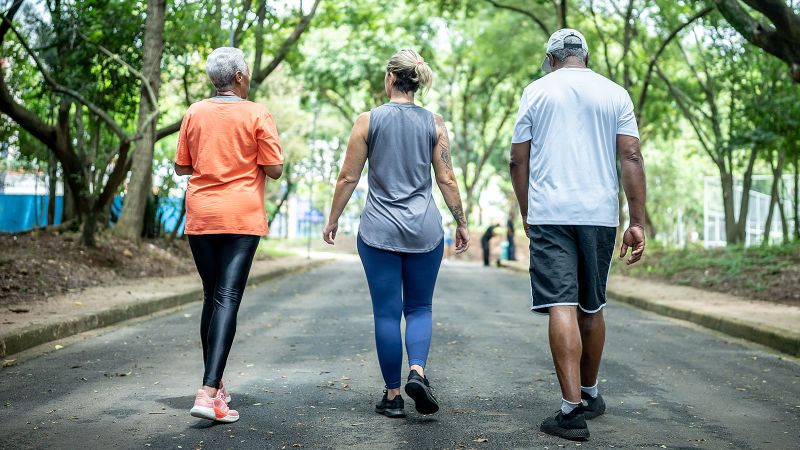Sign up for CNN’s Fitness, But Better newsletter series. Our seven-part guide will help you ease into a healthy routine, backed by experts.
CNN
—
You may be able to lower your risk for developing heart rhythm abnormalities by speeding up your walking pace.
That’s according to a large new study published Tuesday in the journal Heart, which found average or brisk walking paces were associated with 35% and 43% lower risks of all heart rhythm abnormalities studied, respectively, compared with a slow pace.
Those abnormalities are the arrhythmias: atrial fibrillation, bradyarrhythmias and ventricular arrhythmias. Atrial fibrillation, or A-fib, is the most common arrhythmia, characterized by an irregular and rapid heartbeat beginning in the upper chambers, or atria, of the heart. Bradyarrhythmias are abnormally slow heart rates of typically below 60 beats per minute, compared with the normal range of 60 to 100 beats per minute. Ventricular arrhythmias occur when the lower chambers of the heart, or ventricles, beat too fast.
“The great thing about walking is that it is accessible to everyone,” said senior study author Dr. Jill Pell, the Henry Mechan Professor of Public Health at the University of Glasgow in Scotland, via email. “You don’t need to spend money going to a gym or buying equipment. You can just walk out of your front door and keep going.”
Nearly 60 million people worldwide have atrial fibrillation, according to a 2024 study. Estimates of people with other arrhythmias are less conclusive, but in general, people with arrhythmias are at higher risk of having heart attacks or strokes and dying early, Pell said.
“There are medicines and procedures that can be offered to these people but it would be preferable to prevent heart rhythm abnormalities from occurring in the first place,” Pell added.
Additionally, to the authors’ knowledge, there has been only one previous study on walking pace and heart rhythm abnormalities, and it focused on just one type of arrhythmia, Pell said. And past research has indicated that “walking pace is linked to other outcomes such as cardiovascular disease, so we wanted to see if the same was true of heart rhythm abnormalities,” Pell said.
The authors studied health and activity data from adults who had been recruited between 2006 and 2010 for the UK Biobank study, which has followed the health outcomes of more than 500,000 people between the ages 40 and 69 in the United Kingdom. Participants answered questionnaires that asked whether their walking pace was slow (less than 3 miles or 4.8 kilometers per hour), average (3 to 4 miles or 4.8 to 6.4 kilometers per hour) or brisk (more than 4 miles or 6.4 kilometers per hour).
During a follow-up period of 13 years on average, 9% of participants developed arrhythmias.
“We had data on self-reported walking pace from more than 420,000 people but we also had accelerometry data on (nearly) 82,000 of these,” Pell said, referring to data from watches that track movement speed. “The data from the watches showed that walking at an average pace (3-4 miles per hour) for only 5-15 minutes per day was sufficient to reduce your risk.”
The associations were strongest among people under 60, people without obesity, those with high blood pressure or two or more preexisting conditions, and women, the authors found.
“This is an interesting finding because, although women are less likely to get atrial fibrillation than men, when they do get it they are at a higher risk of going on to get heart attacks and strokes than men with atrial fibrillation,” Pell said.
Cardiologist Dr. Martha Gulati found the study important and said it confirms earlier related research — by herself and others — that showed benefits of physical activity for atrial fibrillation and stronger associations among women.
“This shows that one of the primary prevention strategies to reduce cardiac arrhythmias is brisk walking,” added Gulati, director of preventive cardiology at the Smidt Heart Institute at Cedars-Sinai Medical Center in Los Angeles. Gulati wasn’t involved in the research.
The relationship between walking and heart speeds
Since the study is observational, it doesn’t prove a cause and effect, the authors said. Self-reported health data is also vulnerable to inaccurate recollections or biases.
In observational studies, there’s always a risk that people who walk slower do so because they already have disease, Pell said.
“We did everything possible to avoid this by making sure that no one had any type of heart or vascular disease at the beginning of the study,” she added. “However, we really need an intervention study now to confirm our findings: a study of people who walk slowly in which some are asked to increase their walking pace and some are not,” Pell said.
A-Fib is associated with multiple risk factors that are also linked with conditions such as heart disease, diabetes, high blood pressure and obesity, said Dr. Sean Heffron, director of cardiovascular fitness and nutrition at the Center for the Prevention of Cardiovascular Disease at New York University. He was not involved in the study.
Participants who walked faster were more likely to be men, live in less deprived areas, have healthier lifestyles and weigh less. They also had better grip strength, smaller waists and lower levels of inflammation and metabolic risk factors such as high cholesterol or blood sugar.
“And bradyarrhythmias or ventricular arrhythmias are nonspecific and can have lots of other causes and certainly are far less clearly associated with lifestyle-type factors than is atrial fibrillation,” Heffron added. “I feel like lumping them all together was interesting.”
The authors found that over one-third of the beneficial effect of a faster pace “was due to the fact that walking faster reduces cholesterol, glucose and blood pressure and makes you less likely to put on weight,” Pell said, noting that those reductions lower your risk of heart rate abnormalities.
Though a brisk pace seems to be better than a slow pace, “the first step is literally a step,” Gulati said. “Walking slow is how we start, but the more you do it, the faster your pace will become.”

